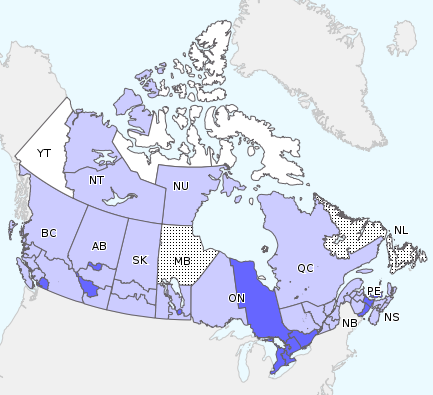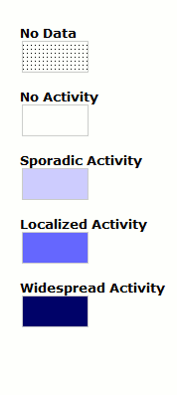FluWatch report: April 10 to April 16, 2016 (week 15)
Overall Summary
- Influenza activity peaked nationally in the second week of March; however, lower but sustained activity continues to be reported throughout the country.
- Many regions across Canada are reporting a greater number of influenza B detections; however, in British Columbia and the Atlantic Region, detections remain predominantly influenza A.
- Hospitalizations, ICU admissions and deaths among the pediatric population, while declining, remain above expected levels based on the past several influenza seasons.
- Despite higher pediatric hospitalizations reported, the pediatric population accounts for the smallest proportion of all deaths reported.
- For more information on the flu, see our Flu(influenza) web page.
Are you a primary health care practitioner (General Practitioner, Nurse Practitioner or Registered Nurse) interested in becoming a FluWatch sentinel for the 2015-16 influenza season? Contact us at FluWatch@phac-aspc.gc.ca
On this page
- Influenza/ILI Activity (geographic spread)
- Laboratory Confirmed Influenza Detections
- Influenza-like Illness Consultation Rate
- Pharmacy Surveillance
- Influenza Outbreak Surveillance
- Sentinel Pediatric Hospital Influenza Surveillance
- Provincial/Territorial Influenza Hospitalizations and Deaths
- Influenza Strain Characterizations
- Antiviral Resistance
- International Influenza Reports
- FluWatch definitions for the 2015-2016 season

Download the alternative format
(PDF format, 908 KB, 9 pages)
Related Topics
Influenza/Influenza-like Illness Activity (geographic spread)
Influenza activity continues to be reported in the majority of regions in Canada. Localized activity was reported in a total of 14 regions across seven provinces. Sporadic activity levels were reported in 31 regions.
Figure 1. Map of overall influenza/ILI activity level by province and territory, Canada, week 15
Note: Influenza/ILI activity levels, as represented on this map, are assigned and reported by Provincial and Territorial Ministries of Health, based on laboratory confirmations, sentinel ILI rates and reported outbreaks. Please refer to detailed definitions at the end of the report. Maps from previous weeks, including any retrospective updates, are available in the mapping feature found in the Weekly Influenza Reports.
Figure 1 - Text Description
Influenza activity continues to be reported in the majority of regions in Canada. Localized activity was reported in a total of 14 regions across seven provinces. Sporadic activity levels were reported in 31 regions.
Laboratory Confirmed Influenza Detections
In week 15, the percentage of tests positive for influenza continued to decrease from the previous week [from 23% in week 14 to 21% in week 15] (Figure 2). Compared to the previous five seasons, the percent positive (21%) reported in week 15 was above the five year average for that week and exceeded the expected levels (range 11.7%-16.9%). With the late start to the 2015-16 influenza season, these elevated levels are not unexpected.
Figure 2. Number of positive influenza tests and percentage of tests positive, by type, subtype and report week, Canada, 2015-16
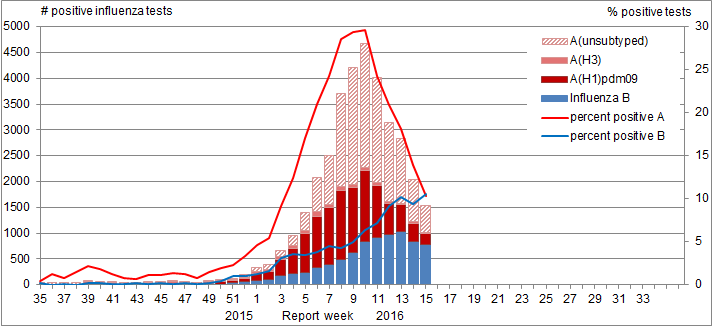
Figure 2 - Text Description
In week 15, the percentage of tests positive for influenza continued to decrease from the previous week [from 23% in week 14 to 21% in week 15].
Nationally in week 15, there were 1,522 positive influenza tests reported. The number of influenza A and influenza B detections were roughly equal in week 15. Many of regions across Canada reported more influenza B detections than influenza A; however, in British Columbia and the Atlantic Region, detections remain predominantly influenza A. To date, 78% of influenza detections have been influenza A and among those subtyped, the vast majority have been influenza A(H1N1) [86% (10715/12443)].
Figure 3. Cumulative numbers of positive influenza specimens by type/subtype and province, Canada, 2015-16
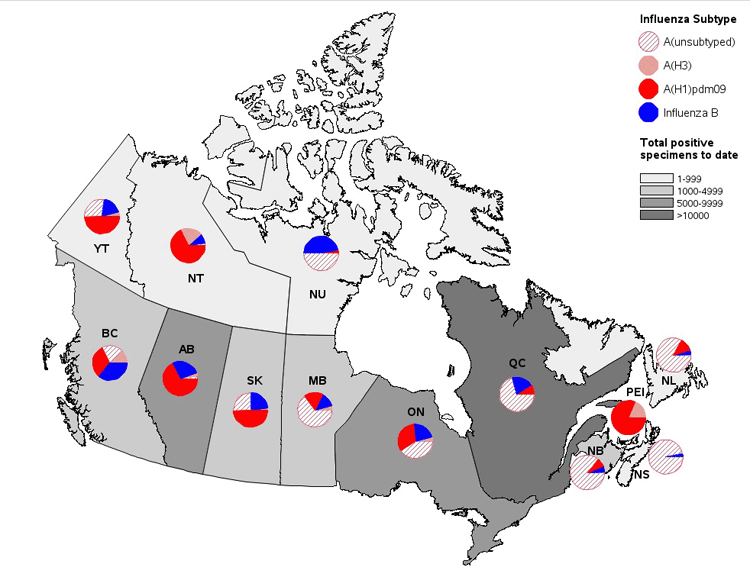
Note: Specimens from NT, YT, and NU are sent to reference laboratories in other provinces. Cumulative data includes updates to previous weeks.
Figure 3 - Text Description
| Reporting provincesTable Figure 3 - Footnote 1 |
Weekly (April 10 to April 16, 2016) | Cumulative (August 30, 2015 to April 16, 2016) | |||||||||
|---|---|---|---|---|---|---|---|---|---|---|---|
| Influenza A | B | Influenza A | B | A & B Total |
|||||||
| A Total |
A (H1)pdm09 |
A (H3) |
A Table Figure 3 - Footnote UnS | B Total |
A Total |
A (H1)pdm09 |
A (H3) |
ATable Figure 3 - Footnote UnS | B Total |
||
|
|||||||||||
| BC | 79 | 67 | <5 | Table Figure 3 - Footnote x | 20 | 1991 | 977 | 350 | 664 | 1115 | 3027 |
| AB | 44 | 36 | <5 | Table Figure 3 - Footnote x | 54 | 3907 | 3607 | 182 | 118 | 1469 | 5376 |
| SK | 16 | 0 | 0 | 16 | 22 | 3001 | 1467 | 46 | 786 | 702 | 3703 |
| MB | 19 | <5 | 0 | Table Figure 3 - Footnote x | 15 | 874 | 179 | 37 | 658 | 140 | 1014 |
| ON | 149 | 40 | <5 | Table Figure 3 - Footnote x | 225 | 7367 | 3159 | 355 | 3853 | 2170 | 9537 |
| QC | 253 | 21 | <5 | Table Figure 3 - Footnote x | 375 | 8581 | 990 | 6 | 7585 | 2218 | 10799 |
| NB | 126 | 11 | <5 | Table Figure 3 - Footnote x | 20 | 1025 | 86 | <5 | Table Figure 3 - Footnote x | 63 | 1088 |
| NS | 16 | 0 | 0 | 16 | <5 | 286 | 0 | <5 | Table Figure 3 - Footnote x | 8 | 294 |
| PE | 7 | 0 | 7 | 0 | Table Figure 3 - Footnote x | 64 | 52 | 12 | 0 | 0 | 64 |
| NL | 15 | 0 | 0 | 15 | <5 | 453 | 58 | <5 | Table Figure 3 - Footnote x | 21 | 474 |
| YT | <5 | <5 | 0 | 0 | 0 | 81 | 49 | <5 | Table Figure 3 - Footnote x | 19 | 100 |
| NT | 0 | 0 | 0 | 0 | <5 | 120 | 90 | 27 | 3 | 12 | 132 |
| NU | 0 | 0 | 0 | 0 | 0 | 16 | <5 | Table Figure 3 - Footnote x | Table Figure 3 - Footnote x | 14 | 30 |
| Canada | 728 | 183 | 16 | 529 | 740 | 27766 | 10715 | 1026 | 15323 | 7951 | 35717 |
| Percentage Table Figure 3 - Footnote 2 | 50% | 25% | 2% | 73% | 50% | 78% | 39% | 4% | 55% | 22% | 100% |
In week 15, individuals under the age of 44 accounted for 74% of influenza B detections. To date this season, detailed information on age and type/subtype has been received for 30,052 cases. Children and teenagers (0-19) accounted for 47% of influenza B cases and approximately one third of all influenza cases. Children and teenagers (0-19), young adults (20-44) and middle-aged adults (45-64) accounted for approximately an equal proportion of influenza A(H1N1) cases (28%).
| Age groups (years) | Weekly (April 10 to April 16, 2016) | Cumulative (August 30, 2015 to April 16, 2016) | ||||||||||
|---|---|---|---|---|---|---|---|---|---|---|---|---|
| Influenza A | B | Influenza A | B | Influenza A and B | ||||||||
| A Total | A(H1) pdm09 | A(H3) | A UnSTable 1 - Footnote 3 | Total | A Total | A(H1) pdm09 | A(H3) | A UnSTable 1 - Footnote 3 | Total | # | % | |
|
||||||||||||
| <5 | 80 | 6 | <5 | Table 1 - Footnote x | 118 | 4396 | 1690 | 67 | 2639 | 1179 | 5577 | 19% |
| 5-19 | 37 | <5 | 0 | Table 1 - Footnote x | 160 | 2346 | 1011 | 97 | 1238 | 2043 | 4391 | 15% |
| 20-44 | 74 | 17 | 0 | 57 | 110 | 5669 | 2699 | 151 | 2819 | 1726 | 7395 | 25% |
| 45-64 | 121 | 28 | <5 | Table 1 - Footnote x | 47 | 6165 | 2709 | 181 | 3275 | 827 | 6992 | 23% |
| 65+ | 101 | 17 | 7 | 77 | 91 | 4608 | 1558 | 410 | 2640 | 1088 | 5697 | 19% |
| Total | 413 | 72 | 11 | 330 | 526 | 23184 | 9667 | 906 | 12611 | 6863 | 30052 | 100% |
| PercentageTable 1 - Footnote 2 | 44% | 17% | 3% | 80% | 56% | 77% | 42% | 4% | 54% | 23% | ||
For data on other respiratory virus detections see the Respiratory Virus Detections in Canada Report on the Public Health Agency of Canada website.
Influenza-like Illness Consultation Rate
The national ILI consultation rate increased from the previous week from 26.1 per 1,000 patient visits in week 14, to 56.4 per 1,000 patient visits in week 15. The highest ILI consultation rate was found in the 5-19 years age group (107.7 per 1,000) and the lowest was found in the ≥65 years age group (14.2 per 1,000) (Figure 4).
Figure 4. Influenza-like-illness (ILI) consultation rates by age group and week, Canada, 2015-16
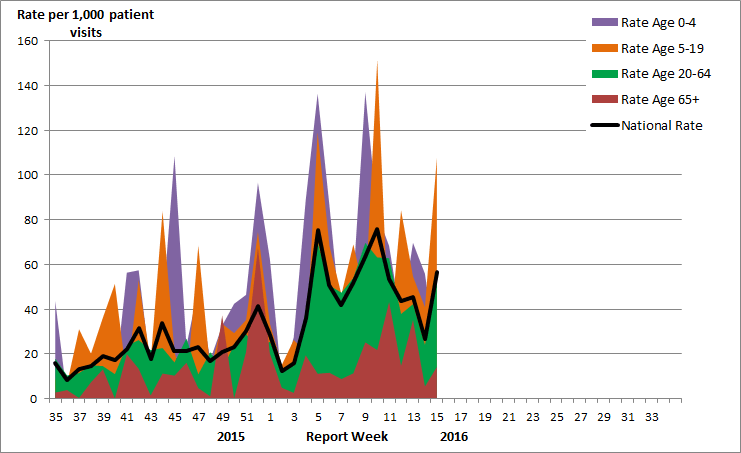
Delays in the reporting of data may cause data to change retrospectively. In BC, AB, and SK, data are compiled by a provincial sentinel surveillance program for reporting to FluWatch. Not all sentinel physicians report every week.
Figure 4 - Text Description
Influenza-like illness consultation rate by age-group in week 15 for the 2015-16 season:
Age 0-4: 18.3; Age 5-19: 107.7; Age 20-64: 53.0; Age 65+: 14.2
Pharmacy Surveillance
During week 15, the proportion of prescriptions for antivirals remained similar to the previous week at 50.6 antiviral prescriptions per 100,000 total prescriptions, which is lower than the five year historical average for week 15. The proportion of prescriptions for antivirals remains highest among children. In week 15, the proportion reported among children was 100.1 per 100,000 total prescriptions.
Figure 5. Proportion of prescription sales for influenza antivirals by age group and week, Canada, 2015-16
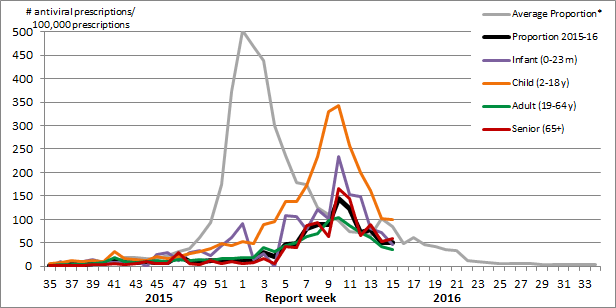
Note: Pharmacy sales data are provided to the Public Health Agency of Canada by Rx Canada Inc. and sourced from major retail drug chains representing over 3,000 stores nationwide (excluding Nunavut) in 85% of Health Regions. Data provided include the number of new antiviral prescriptions (for Tamiflu[oseltamivir] and Relenza [zanamivir]) and the total number of new prescriptions dispensed by Province/Territory and age group.
* The average weekly proportion includes data from April 2011 to March 2015.
Figure 5 - Text Description
Proportion of antiviral prescriptions per 100,000 total prescriptions
Average National Rate (Yrs 10-11 to 14-15): 84.8.; Rate wk 15: 50.6
Proportion of antiviral prescriptions by age-group in week 15 for the 2015-16 season:
Infant: 47.1; child: 100.2; adult: 36.1; senior: 59.9
Influenza Outbreak Surveillance
In week 15, 12 new laboratory confirmed influenza outbreaks were reported: 11 in long-term care facilities (LTCF) and one in a hospital. Of the seven outbreaks with known strains or subtypes, four outbreaks were due to influenza B (three in LTCFs and one in a hospital), one outbreak each was due to influenza A(H1N1) and influenza A(H3N2) (both in LTCFs), and one outbreak in a LTCF was due to influenza A(UnS). Additionally, one ILI outbreak was reported in a school.
To date this season, 387 outbreaks have been reported. At week 15 in the 2014-15 season, 1,586 outbreaks were reported and in the 2013-14 season, 210 outbreaks were reported.
Figure 6. Overall number of new laboratory-confirmed influenza outbreaksFigure 5 - Footnote 1 by report week, Canada, 2015-2016
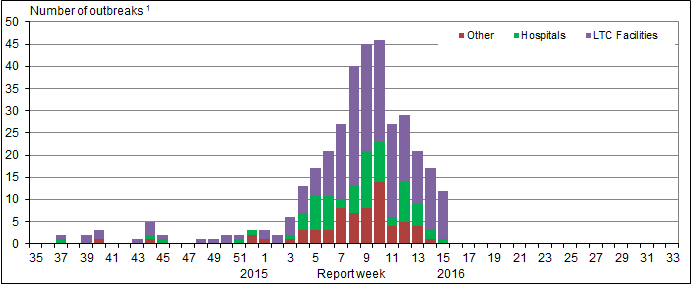
Figure 6 - Text Description
| Report week | Hospitals | Long Term Care Facilities | Other |
|---|---|---|---|
| 35 | 0 | 0 | 0 |
| 36 | 0 | 0 | 0 |
| 37 | 1 | 1 | 0 |
| 38 | 0 | 0 | 0 |
| 39 | 0 | 2 | 0 |
| 40 | 0 | 2 | 1 |
| 41 | 0 | 0 | 0 |
| 42 | 0 | 0 | 0 |
| 43 | 0 | 1 | 0 |
| 44 | 1 | 3 | 1 |
| 45 | 1 | 1 | 0 |
| 46 | 0 | 0 | 0 |
| 47 | 0 | 0 | 0 |
| 48 | 0 | 1 | 0 |
| 49 | 0 | 1 | 0 |
| 50 | 0 | 2 | 0 |
| 51 | 1 | 1 | 0 |
| 52 | 1 | 0 | 2 |
| 1 | 0 | 2 | 1 |
| 2 | 0 | 2 | 0 |
| 3 | 1 | 4 | 1 |
| 4 | 4 | 6 | 3 |
| 5 | 8 | 6 | 3 |
| 6 | 8 | 10 | 3 |
| 7 | 2 | 17 | 8 |
| 8 | 6 | 27 | 7 |
| 9 | 13 | 24 | 8 |
| 10 | 9 | 23 | 14 |
| 11 | 2 | 21 | 4 |
| 12 | 9 | 15 | 5 |
| 13 | 5 | 12 | 4 |
| 14 | 2 | 14 | 1 |
| 15 | 1 | 11 | 0 |
Sentinel Pediatric Hospital Influenza Surveillance
Paediatric Influenza Hospitalizations and Deaths
In week 15, 63 laboratory-confirmed influenza-associated pediatric (≤16 years of age) hospitalizations were reported by the Immunization Monitoring Program Active (IMPACT) network (Figure 7). The largest proportion of hospitalizations were in children aged 5-9 years, accounting for 33% of the hospitalizations. Similar to the previous week, more influenza B cases were reported than influenza A cases (41 vs. 22 respectively).
To date this season, 1,207 hospitalizations have been reported by the IMPACT network: 874 hospitalized cases (72%) were due to influenza A and 333 cases (28%) were due to influenza B. The greatest proportion of hospitalized cases were in children aged 0-2 years (40%). To date,192 intensive care unit (ICU) admissions have been reported. Children aged 2 to 4 and 5 to 9 years accounted for 28% and 26% respectively of ICU admissions. A total of 122 ICU cases (64%) reported at least one underlying condition or comorbidity. Eight influenza-associated deaths have been reported.
| Age Groups | Cumulative (30 Aug. 2015 to 16 April 2016) | |||||
|---|---|---|---|---|---|---|
| Influenza A | Influenza B | Influenza A and B (#(%)) | ||||
| A Total | A(H1) pdm09 | A(H3) | A (UnS) | B Total | ||
|
||||||
| 0-5m | 116 | 32 | 5 | 79 | 26 | 142 (12%) |
| 6-23m | 270 | 73 | 7 | 190 | 66 | 336 (28%) |
| 2-4y | 251 | 79 | <5 | Table 2 - Footnote x | 93 | 344 (29%) |
| 5-9y | 179 | 47 | <5 | Table 2 - Footnote x | 106 | 285 (24%) |
| 10-16y | 58 | 18 | <5 | Table 2 - Footnote x | 42 | 100 (8%) |
| Total | 874 | 249 | 21 | 604 | 333 | 1207 (100%) |
Figure 7. Number of cases of influenza reported by sentinel hospital networks, by week, Canada, 2015-16, paediatric and adult hospitalizations (≤16 years of age, IMPACT; ≥16 years of age, CIRN-SOS)
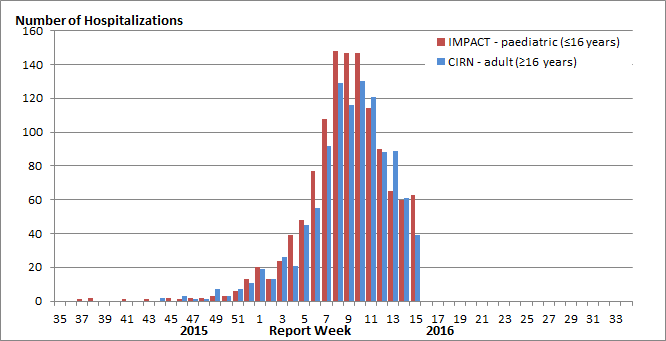
Not included in Table 2 and Figure 7 are two IMPACT cases that were due to co-infections of influenza A and B.
Figure 7 - Text Description
| Report week | IMPACT | CIRN-SOS |
|---|---|---|
| 35 | 0 | 0 |
| 36 | 0 | 0 |
| 37 | 1 | 0 |
| 38 | 2 | 0 |
| 39 | 0 | 0 |
| 40 | 0 | 0 |
| 41 | 1 | 0 |
| 42 | 0 | 0 |
| 43 | 1 | 0 |
| 44 | 0 | 2 |
| 45 | 2 | 0 |
| 46 | 1 | 3 |
| 47 | 2 | 1 |
| 48 | 2 | 1 |
| 49 | 3 | 7 |
| 50 | 3 | 3 |
| 51 | 6 | 7 |
| 52 | 13 | 11 |
| 1 | 20 | 19 |
| 2 | 13 | 13 |
| 3 | 24 | 26 |
| 4 | 39 | 21 |
| 5 | 48 | 45 |
| 6 | 77 | 55 |
| 7 | 108 | 92 |
| 8 | 148 | 129 |
| 9 | 147 | 116 |
| 10 | 147 | 130 |
| 11 | 114 | 121 |
| 12 | 90 | 88 |
| 13 | 65 | 89 |
| 14 | 60 | 61 |
| 15 | 63 | 39 |
Adult Influenza Hospitalizations and Deaths
In week 15, 39 laboratory-confirmed influenza-associated adult (≥16 years of age) hospitalizations were reported by the Canadian Immunization Research Network Serious Outcome Surveillance (CIRN-SOS) (Figure 7). The largest proportion of hospitalizations was in adults 65+ years of age (54%) and due to influenza A (62%). In recent weeks, the weekly number of hospitalizations reported by CIRN has been decreasing and an increasing proportion of hospitalizations have been due to influenza B.
To date this season, 1,077 hospitalizations have been reported by CIRN-SOS (Table 3). The majority of hospitalized cases were due to influenza A (83%) and the largest reported proportion was among adults ≥65 years of age (50%). One hundred and sixty-five intensive care unit (ICU) admissions have been reported. A total of 112 ICU cases reported at least one underlying condition or comorbidity. A total of 45 deaths have been reported this season with the majority of deaths reported in adults ≥65 years of age (64%).
| Age groups (years) | Cumulative (1 Nov. 2015 to 16 April 2016) | |||||
|---|---|---|---|---|---|---|
| Influenza A | B | Influenza A and B | ||||
| A Total | A(H1) pdm09 | A(H3) | A(UnS) | Total | # (%) | |
|
||||||
| 16-20 | Table 3 - Footnote x | <5 | 0 | <5 | <5 | 7 (1%) |
| 20-44 | 140 | 45 | <5 | Table 3 - Footnote x | 36 | 176 (16%) |
| 45-64 | 312 | 94 | <5 | Table 3 - Footnote x | 39 | 351 (33%) |
| 65+ | 434 | 119 | 23 | 292 | 103 | 537 (50%) |
| Unknown | <5 | 0 | 0 | <5 | <5 | 6 (1%) |
| Total | 895 | 264 | 27 | 604 | 182 | 1077 |
| % | 83% | 29% | 3% | 67% | 17% | 100% |
Figure 8. Percentage of hospitalizations, ICU admissions and deaths with influenza reported by age-group (≥16 year of age), Canada 2015-16

Note: The number of hospitalizations reported through CIRN-SOS and IMPACT represents a subset of all influenza-associated adult and paediatric hospitalizations in Canada. Delays in the reporting of data may cause data to change retrospectively.
x - Suppressed to prevent residual disclosure.
Figure 8 - Text Description
| Age-group (years) | Hospitalizations (n=1071) | ICU admissions (n=165) | Deaths (n=45) |
|---|---|---|---|
|
|||
| 16-20 | 0.7% | Table Figure 8 - Footnote x% | Table Figure 8 - Footnote x% |
| 20-44 | 16.4% | Table Figure 8 - Footnote x% | Table Figure 8 - Footnote x% |
| 45-64 | 32.8% | 44.8% | 31.1% |
| 65+ | 50.1% | 35.2% | 64.4% |
Provincial/Territorial Influenza Hospitalizations and Deaths
Since the start of the 2015-16 season, 4,606 laboratory-confirmed influenza-associated hospitalizations have been reported. A total of 3,802 hospitalizations (83%) were due to influenza A and 804 (17%) were due to influenza B. Of the 486 ICU admissions reported, 258 (53%) were due to influenza A(H1N1). A total of 193 deaths have been reported; all but 24 were associated with influenza A.
Overall this season, hospitalizations have been reported more frequently among adults ≥65 years of age. The largest proportion of ICU admissions was reported in adults 45-64 years of age and the highest proportion of fatal cases was reported in adults ≥65 years of age. Pediatric (0-19 years) and young to middle-aged adults (20-44 years) accounted for 42% of all hospitalizations and 14% of all deaths reported to date this season. There have been more pediatric hospitalizations reported to date compared to the year-end totals in each of the previous four influenza seasons.
Figure 9. Percentage of hospitalizations, ICU admissions and deaths with influenza reported by age-group, Canada 2015-16

Figure 9 - Text Description
| Age-group (years) | Hospitalizations (n=4606) | ICU admissions (n=486) | Deaths (n=212) |
|---|---|---|---|
| 0-4 | 19.1% | 8.6% | 2.4% |
| 5-19 | 9.2% | 6.0% | 3.3% |
| 20-44 | 13.2% | 18.1% | 8.5% |
| 45-64 | 27.0% | 45.5% | 36.8% |
| 65+ | 31.5% | 21.8% | 49.1% |
See additional data on Reported Influenza Hospitalizations and Deaths in Canada: 2011-12 to 2015-16 on the Public Health Agency of Canada website.
Influenza Strain Characterizations
During the 2015-16 influenza season, the National Microbiology Laboratory (NML) has characterized 1,901 influenza viruses [189 A(H3N2), 1,099 A(H1N1) and 613 influenza B].
Influenza A (H3N2): When tested by hemagglutination inhibition (HI) assays, 48 A(H3N2) viruses were antigenically characterized as A/Switzerland/9715293/2013-like using antiserum raised against cell-propagated A/Switzerland/9715293/2013.
Sequence analysis was done on 141 A(H3N2) viruses. All viruses belonged to a genetic group for which most viruses were antigenically related to A/Switzerland/9715293/2013. A/Switzerland/9715293/2013 is the A(H3N2) component of the 2015-16 Northern Hemisphere's vaccine.
Influenza A (H1N1): All of the 1,099 A(H1N1) viruses characterized were antigenically similar to A/California/7/2009, the A(H1N1) component of the 2015-16 influenza vaccine.
Influenza B: A total of 142 influenza B viruses characterized were antigenically similar to the vaccine strain B/Phuket/3073/2013. A total of 471 influenza B viruses were characterized as B/Brisbane/60/2008-like, one of the influenza B components of the 2015-16 Northern Hemisphere quadrivalent influenza vaccine.
The recommended components for the 2015-2016 northern hemisphere trivalent influenza vaccine include: an A/California/7/2009(H1N1)pdm09-like virus, an A/Switzerland/9715293/2013(H3N2)-like virus, and a B/Phuket/3073/2013 -like virus (Yamagata lineage). For quadrivalent vaccines, the addition of a B/Brisbane/60/2008-like virus (Victoria lineage) is recommended.
The NML receives a proportion of the influenza positive specimens from provincial laboratories for strain characterization and antiviral resistance testing. Characterization data reflect the results of haemagglutination inhibition testing compared to the reference influenza strains recommended by WHO.
Antiviral Resistance
During the 2015-16 season, the National Microbiology Laboratory (NML) has tested 1,178 influenza viruses for resistance to oseltamivir, 1,179 for resistance to zanamivir and 1,233 influenza viruses for resistance to amantadine. All but eight tested viruses were sensitive to oseltamivir. The eight H1N1 viruses resistant to oseltamivir had a H275Y mutation. All viruses tested for resistance were sensitive to zanamivir. All but one influenza A viruses were resistant to amantadine (Table 4).
| Virus type and subtype | Oseltamivir | Zanamivir | Amantadine | |||
|---|---|---|---|---|---|---|
| # tested | # resistant (%) | # tested | # resistant (%) | # tested | # resistant (%) | |
|
||||||
| A (H3N2) | 147 | 0 | 147 | 0 | 193 | 192 (99.5%) |
| A (H1N1) | 728 | 8 | 729 | 0 | 1040 | 1040 (100%) |
| B | 303 | 0 | 303 | 0 | NATable 4 - Footnote * | NATable 4 - Footnote * |
| Total | 1178 | 8 | 1179 | 0 | 1233 | 1232 |
International Influenza Reports
- World Health Organization influenza update
- World Health Organization FluNet
- WHO Influenza at the human-animal interface
- Centers for Disease Control and Prevention seasonal influenza report
- European Centre for Disease Prevention and Control - epidemiological data
- South Africa Influenza surveillance report
- New Zealand Public Health Surveillance
- Australia Influenza Report
- Pan-American Health Organization Influenza Situation Report
FluWatch definitions for the 2015-2016 season
Abbreviations: Newfoundland/Labrador (NL), Prince Edward Island (PE), New Brunswick (NB), Nova Scotia (NS), Quebec (QC), Ontario (ON), Manitoba (MB), Saskatchewan (SK), Alberta (AB), British Columbia (BC), Yukon (YT), Northwest Territories (NT), Nunavut (NU).
Influenza-like-illness (ILI): Acute onset of respiratory illness with fever and cough and with one or more of the following - sore throat, arthralgia, myalgia, or prostration which is likely due to influenza. In children under 5, gastrointestinal symptoms may also be present. In patients under 5 or 65 and older, fever may not be prominent.
ILI/Influenza outbreaks
- Schools:
-
Greater than 10% absenteeism (or absenteeism that is higher (e.g. >5-10%) than expected level as determined by school or public health authority) which is likely due to ILI.
Note: it is recommended that ILI school outbreaks be laboratory confirmed at the beginning of influenza season as it may be the first indication of community transmission in an area. - Hospitals and residential institutions:
- two or more cases of ILI within a seven-day period, including at least one laboratory confirmed case. Institutional outbreaks should be reported within 24 hours of identification. Residential institutions include but not limited to long-term care facilities ( LTCF) and prisons.
- Workplace:
- Greater than 10% absenteeism on any day which is most likely due to ILI.
- Other settings:
- two or more cases of ILI within a seven-day period, including at least one laboratory confirmed case; i.e. closed communities.
Note that reporting of outbreaks of influenza/ILI from different types of facilities differs between jurisdictions.
Influenza/ILI activity level
1 = No activity: no laboratory-confirmed influenza detections in the reporting week, however, sporadically occurring ILI may be reported
3 = Localized:
- evidence of increased ILIFootnote * and
- lab confirmed influenza detection(s) together with
- outbreaks in schools, hospitals, residential institutions and/or other types of facilities occurring in less than 50% of the influenza surveillance regionFootnote †
4 = Widespread:
- evidence of increased ILIFootnote * and
- lab confirmed influenza detection(s) together with
- outbreaks in schools, hospitals, residential institutions and/or other types of facilities occurring in greater than or equal to 50% of the influenza surveillance regionFootnote †
Note: ILI data may be reported through sentinel physicians, emergency room visits or health line telephone calls.
